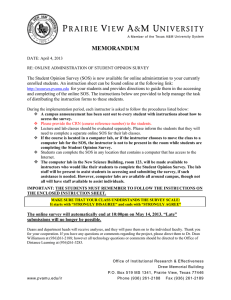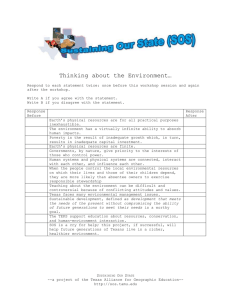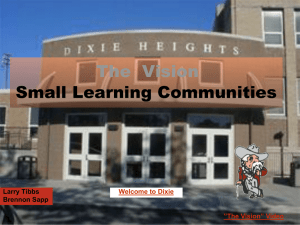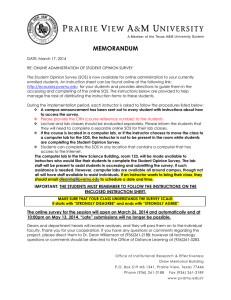The Vision SMALL LEARNING COMMUNITIES & TRIMESTER SCHEDULING Larry Tibbs
advertisement
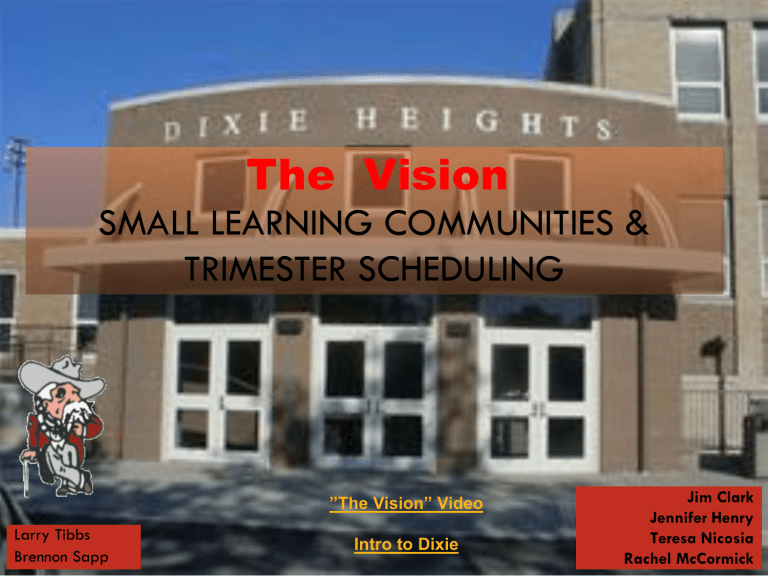
The Vision SMALL LEARNING COMMUNITIES & TRIMESTER SCHEDULING ”The Vision” Video Larry Tibbs Brennon Sapp Intro to Dixie Jim Clark Jennifer Henry Teresa Nicosia Rachel McCormick Agenda for Today Trimester-Basics (10-15 minutes) SOS Video (10-15 minutes) Intro to SOS (60+ minutes) SOS Details & What it means for You Lunch (50-70 minutes) SOS Lessons/Flavoring (15 + 90 minutes) Average Presenter Presentation Time = 4.5 hrs Average Salary of Presenters = $54,000 Average Age of Presenters = 43 Average Years of Experience = 16 What is in this for me? Agenda for Today 1. 2. 3. 4. 5. 6. Trimester-Basics (14 minutes) SOS Video (11 minutes 53 seconds) Intro to SOS (63 minutes) SOS Details & What it means for You Lunch (60 minutes) SOS Lessons/Flavoring (15 + 90 minutes) – – – – Math Science English Social Studies – Group I Electives – Group II Electives We would also like to know why we are doing this, who has done it before, and how long we will be doing it? Agenda for Today We will tell you about ourselves Trimester-Basics (10-15 minutes) SOS Video (11 minutes) Intro to SOS (60+ minutes) SOS Details & What it means Lunch (?) SOS Lessons/Flavoring (15 + 90 minutes) Whole Group (we will try to be friendly) Math Science English Social Studies In small groups & collaborative Group I Electives Group II Electives Eat with who you like! Yes, we would love to answer your emails Trimester-Basics Agenda • • • • • • Three-12 week grading periods each year Each class is worth ½ credit – Traditional 1 credit classes are split into A/B – Most AP/Dual credit classes are A/B/C Five Classes each day Each class will be 70 minutes long Each 12 week term is a ½ credit Students will take a total of fifteen-½ credit classes each school year 1st Period 2nd Period 3rd Period (Lunch) 4th Period 5th Period Lunch #1 Lunch #2 Lunch #3 Lunch #4 7:50- 9:00 9:05-10:15 10:20-11:53 11:58- 1:08 1:13- 2:30 10:15-10:38 10:40-11:03 11:05-11:28 11:30-11:53 (23 (23 (23 (23 minutes) minutes) minutes) minutes) Graduation Requirements: English Mathematics - 4 units: - 4 units: English I, II, III, & IV Must include Algebra I-A & I-B and Geometry * Science - 3.5 units: CSI, Core Life, Physical & Earth/Space Science required, plus 1.5 credits other Science credits. Social Studies - 3 units: Intro. to Social Studies and World Civilization recommended, U.S. History required Health -1/2 unit Physical Education -1/2 unit Arts & Humanities - 1 unit Business Principles - 1 unit (formerly Keyboarding) & Tech. Applications Electives - 10.5 units _______________________________ Total - 28 units *Beginning with the class of 2007, prep algebra will be considered only as an elective credit, not a math credit towards graduation. (Beginning with Class of 2011) Sophomore - 6 credits (including English I) Junior - 13 credits (including English I, II) Senior – 20.5 credits (including English I, II, III) Shorter class periods than block More options for creativity in classes ◦ A and B classes ◦ ½ credit electives ◦ ½ credit requirements More “Fresh Starts” Students may retake “part” of a class More chances for immediate remediation More flexibility in student schedules More flexibility in graduation requirements Room for study skills A and B Course solve/cause problems ◦ A before B? ◦ Is part B necessary? ◦ Same teacher? Number of Preps, it’s a problem ◦ Within the trimester ◦ Within the year Pre-requisites everywhere. . . Or not? Lunch Schedule--Early or Late? Singletons – Innovative electives create more singletons Placement of special courses ◦ V-school ◦ Dual credit (colleges are on semesters) ◦ Remediation opportunities The Vision SMALL LEARNING COMMUNITIES ”The Vision” Video-Year 1 in Reflection Our Schools of Study The School of Visual/Performing Arts and Media (VPAM) Characteristics: – – – – – – – – – – complicated emotional Abilities expressive writing idealistic musical imaginative artistic impulsive independent introspective intuitive nonconforming Jobs: – – – – – – – – – – – composer musician stage director writer interior decorator actor/actress event coordinator reporter artist photographer advertisement executive The School of Science, Technology, Engineering & Math (STEM) Characteristics: Jobs: – analytical – cautious Abilities – complex mechanical mathematic – critical scientific – curious – Intellectual – introverted, – methodical – precise – rational – – – – – – – – – – – mechanic aircraft controller surveyor farmer electrician biologist chemist physicist anthropologist geologist med tech The School of Law, Education, Health & Human Services (LEHH) Characteristics: cooperative generous Abilities helpful social idealistic verbal emotional patient responsible social sympathetic understanding warm Jobs: teacher religious worker counselor psychologist social worker speech therapist police officer lawyer nurse nutritionist physical therapist sociologist (BIT) Business & Information Technology The School of Characteristics: acquisitive adventurous agreeable Abilities ambitious leadership speaking extroverted clerical energetic attention-getting impulsive optimistic popular self-confident Jobs: salesperson manager business executive television producer sports promoter buyer bookkeeper stenographer financial analyst banker cost estimator tax expert Freshman Academy • • • • Team approach Most critical year Various support programs Used as a vehicle to introduce students to the Schools of Study (Decision point) • Freshman Coordinator and a Freshman Administrator • Pathways (Advisory) Establish a Vision Team • A group to trail blaze the path to the New Dixie Heights High School – Professional development – Time line/steps – Advocates for change • Hand Picked Committee (12) – Teacher leaders – Representative group – Visionaries • SOS Lead Teachers Spreading the Word • “The Vision” – Promotional Video • School of Study – Websites – Brochures – Videos – Parent Information Nights • SOS Sample Videos • To Students – Surveys – Videos – Freshman Academy (lessons, advisory, and posters) Curriculum Development • Model Lessons • Flavoring of Core Content Classes (Relevancy) • Collaborative Lessons • Business/Community Involvement • Development of New Electives Science Then • Three Required Classes – Biology (1 credit-freshman) – Earth/Space Science (1 credit) – Integrated Science (1 credit) • Electives – Chemistry (1 credit) – Anatomy & Physiology (1 credit) – Physics (1 credit) – Environmental Science (1 credit) – AP Chemistry (2 credits) – AP Biology (2 credits) Science Now Three and a Half Required Classes • • • • • Scientific Investigations (1/2 credit-freshman) Life Science (1/2 credit) Earth/Space Science (1/2 credit) Physical Science (1/2 credit) 1½ credits to be spread out in electives Electives (all ½ credit, save AP Classes) – – – – – – – – – – Chemistry A & B – Anatomy A & B – Physics A & B – Environmental Science – Forensics – Zoology – Astronomy Chemistry & Community – Oceanography/Marin Biology Medical Science Radio Technology Horticulture Geology Meteorology Anatomy for Artist AP Chemistry AP Biology Career Pathways • SOS – Pathway • Occupations – Recommended Courses • LEHHS – Education/Psychology • Counselor – Child Development – Psychology –.... Establishing Business Partnership • Business Partnership Receptions • Business Partner Liaison • Externships • Business Panels Entrepreneurship Project • Research/Identify Business Site • Formal Presentation • Business Mentors Building SOS Identity • • • • • • • SOS/Student Data Bases Student Advisory Councils SOS Pathway Groups Career Mini-sessions SOS Team Meetings SOS Celebration SOS Course Selection Sheets Questions? www.dixie.kenton.kyschools.us www.bsapp.com/Schools_of_Study.htm •South Grand Prairie (TX) sgphs.gpisd.org •Kennesaw Mountain (GA) www.cobb.k12.ga.us/~kennesawmountain •Pulaski County (KY) www.pcva.us/schools/pchs/index.htm

